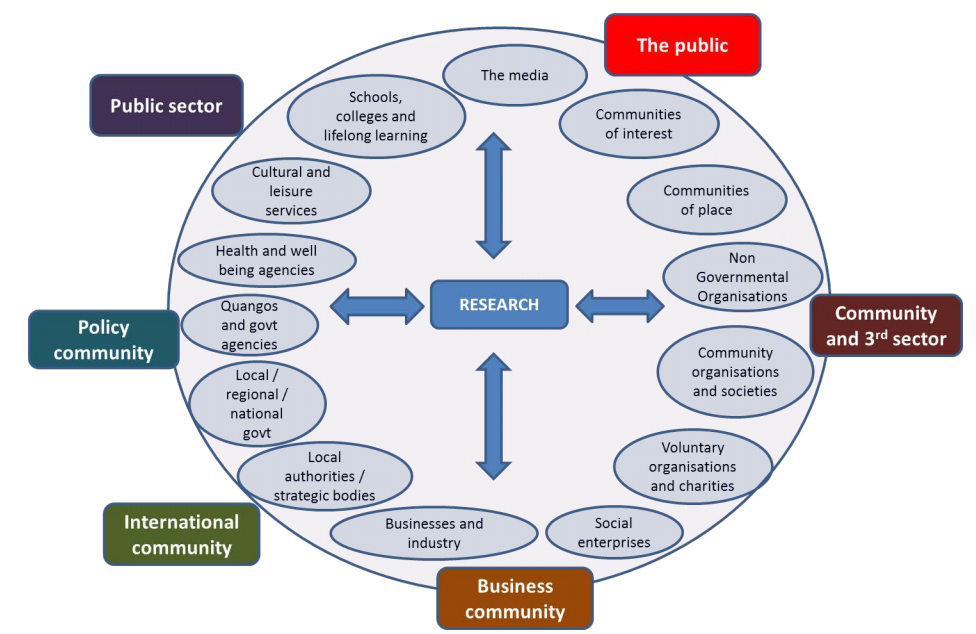9 Research Impact Things
Identifying research end-users
Identifying your research end users, those who are stakeholders, i.e. groups, organisations or segments of society who directly use your research at any stage, as well as those who are beneficiaries from your research outcomes, is a crucial part of achieving impact. Stakeholders and beneficiaries need to be identified early in the planning process, in tandem with Identifying your goals.
Getting started
Consider the full diversity of groups that might be affected by your research in any way, positively or negatively: those who will be benefitted and those it might negatively impact; and those who will directly use your research or will benefit from the outcomes of your research. It will be helpful to consider the effects on stakeholders and beneficiaries ahead of time in order to develop strategies to promote the benefits and mitigate the disadvantages for the different research end-users. Also consider those who might not be otherwise affected by the research but could potentially have a positive affect on the research if brought on board.
-
The Impact Planning Toolkit from Sheffield University provides a good introduction to the most important considerations when identifying research end-users and how their interests should inform your activities through the research process.
-
Who are your research end-users?
- Take a look at the Stakeholders in Research document from Sheffield University to get some idea of the groups that might be stakeholders or beneficiaries and their categories.

Stakeholders in research by National Co-ordinating Centre for Public Engagement.
- Take a look at the Stakeholders in Research document from Sheffield University to get some idea of the groups that might be stakeholders or beneficiaries and their categories.
- Steps 1 and 2 of the mapping your audience section of the UK Health Foundation Research Communication toolkit have some suggestions for identifying research end-users with a Health Sciences focus.
Learn more
Determine the best strategy to manage your research end-users by mapping out and prioritising all of your stakeholder groups based on their potential influence on and interest in your research.
-
Use Curtin Research EI Toolkit Research end-user analysis Template [XLSX, 18kB] to identify the key considerations of each group of stakeholders or beneficiaries, focusing on their levels of interest and influence. Then prioritise the groups, and plan the best strategies to adopt with each.
-
Alternatively, explore the Alignment Interest and Influence Matrix (AIIM),a commonly used tool for analysing project stakeholders. The Overseas Development Institute (ODI) guide [PDF, 321kB] demonstrates how AIIM can be applied to a research project.
Explore in depth
The following steps build upon those in the previous sections and cover aspects of the process in greater depth.
-
Align your Impact Goals with the research end-users you have decided to target and plot how you will engage with each group in order to achieve your goals. The Fast Track Impact Planning Template [PDF, 219kB] is a more detailed version of the basic Stakeholder and Public Analysis template that incorporates mapping out engagement activities for each group, identifying risks, and developing an engagement timeline. If you wish to identify your goals and research end-users in tandem this could be a useful template to adopt.
-
Develop a policy influence plan which builds on the AIIM stakeholder map using the ODI Mental Health Policy Toolkit (Pages 9-14) in order to refine ideas on how to influence attitudes and behaviour of a research end-user group.
-
Read Stakeholder Interaction in Research Processes (pages 18-21) [PDF, 484kB] for some suggestions for how to involve and communicate with research end-users from their initial engagement through to the end of the project.
-
Improve your knowledge of the researcher end-user groups and their interests by investigating them earlier in the project, particularly if they have been identified as having the potential for a high level of engagement. Find and collaborate with a colleague who knows more about the stakeholders or beneficiaries, and consider inviting someone from outside of academia who works with key groups you wish to reach, and get them to advise you.